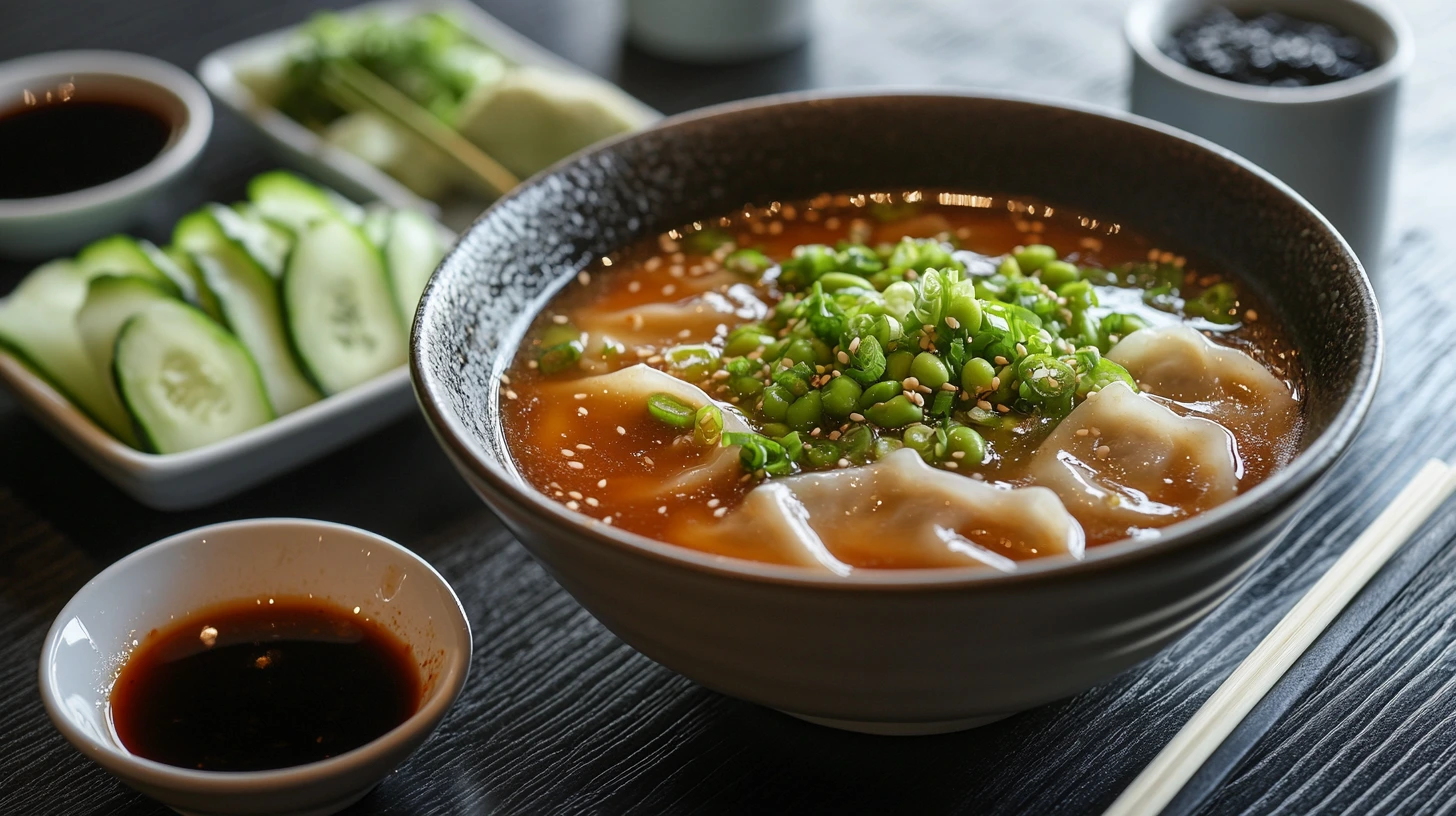When the weather cools down or your body craves a warm hug in a bowl, few dishes hit the spot like Potsticker Soup. This delightful fusion of juicy dumplings and savory broth offers a hearty, comforting meal that’s as easy to make as it is satisfying to eat. Whether you’re a seasoned home cook or just looking for a simple yet delicious recipe to try, Potsticker Soup brings together the best of both worlds: convenience and culinary charm.
Packed with fresh vegetables, flavorful broth, and tender potstickers that soak up every delicious drop, Potsticker Soup is quickly becoming a go-to dish in homes around the world. Its adaptability to various diets and ingredients makes it suitable for nearly everyone. From a quick weeknight meal to a cozy weekend indulgence, this soup proves that comfort food doesn’t have to be complicated.
In this guide, we’ll explore everything you need to know about Potsticker Soup—from its origins and ingredient breakdown to how to make it, customize it, and even store it for later. Get ready to discover why this simple dish is making a big impact.
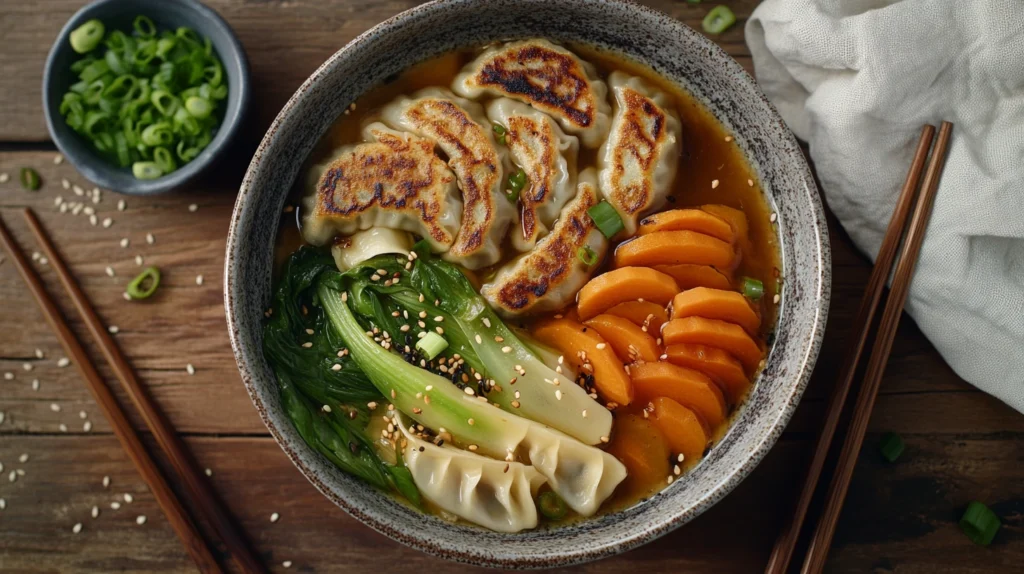
What is Potsticker Soup?
Origins of Potstickers and Soup Fusion
Potstickers, also known as guo tie in Mandarin, originated in Northern China and are traditionally pan-fried dumplings filled with pork, vegetables, or seafood. These dumplings have been a beloved part of Asian cuisine for centuries, cherished for their crispy bottoms and juicy interiors. While potstickers are typically served on their own with dipping sauces, creative cooks and home chefs started incorporating them into soups for a more filling, nourishing meal.
The idea of turning dumplings into a soup base isn’t new—many Asian cuisines feature dumpling soups, like wonton soup in China or mandu-guk in Korea. However, Potsticker Soup is a more recent culinary fusion that blends the robust texture of potstickers with flavorful broths and fresh produce. The result? A heartwarming bowl that’s both nostalgic and modern.
Why Potsticker Soup is Gaining Popularity
There are a few key reasons Potsticker Soup is skyrocketing in popularity, especially across social media and food blogs:
- Convenience: Many people use frozen potstickers, making the dish quick and easy to prepare in under 30 minutes.
- Customizability: You can tailor the soup to your taste—spicy, creamy, low-carb, vegetarian—you name it.
- Flavor Depth: Unlike simple broths, Potsticker Soup packs complex flavors thanks to ingredients like sesame oil, garlic, soy sauce, and ginger.
- Comfort Food Appeal: It’s the ultimate comfort food. Think of it like chicken noodle soup’s Asian cousin—hearty, slurpable, and perfect for cold days or sick days.
Beyond just taste, Potsticker Soup has a visual appeal that makes it perfect for Instagram-worthy food posts. With vibrant vegetables, golden-brown dumplings, and steaming broth, it’s as beautiful as it is delicious.
Potstickers (or guo tie) have roots in Northern China, traditionally served pan-fried with dipping sauce. But when you add them to a flavorful broth, they transform into a soul-warming soup that rivals other comfort classics like Red Curry Meatballs.
This recipe puts a global spin on tradition—much like how Black Pepper Chicken brings bold Asian flavors to your weeknight dinner table.
Key Ingredients in Potsticker Soup
Choosing the Right Potstickers: Frozen vs Homemade
The star of this soup is, without question, the potstickers themselves. But the question many home cooks face is whether to go for store-bought frozen dumplings or make them from scratch.
Frozen potstickers are the most convenient option. They’re widely available in grocery stores, often pre-filled with pork, chicken, shrimp, or vegetarian options. They’re precooked or partially cooked, making them a quick and reliable choice. Popular brands like Trader Joe’s, Bibigo, and Ling Ling offer excellent quality and flavor.
Homemade potstickers, on the other hand, allow for full control over the filling. From spiced tofu and mushroom to traditional pork with scallions, making them from scratch brings authenticity and a sense of pride to the dish. They can be frozen in batches for future use, making the effort worthwhile.
💡 Tip: If you’re using frozen potstickers, there’s no need to thaw them—just drop them directly into the simmering broth and extend the cook time by a few minutes.
Broth Basics: Chicken, Vegetable, or Bone Broth?
The broth forms the flavorful foundation of potsticker soup. Choosing the right one sets the tone for the entire dish:
- Chicken Broth: The classic choice, offering a savory and balanced taste. Low-sodium versions allow more control over salt levels.
- Vegetable Broth: Ideal for vegetarian or vegan versions, especially when paired with plant-based dumplings.
- Bone Broth: Packed with protein, collagen, and depth, bone broth adds a nutritional and umami boost.
For enhanced flavor, consider infusing the broth with fresh aromatics like garlic, ginger slices, scallions, soy sauce, sesame oil, or a splash of rice vinegar. A small amount of white miso paste can also create a richer, more savory profile.
Vegetables that Complement Potsticker Soup
Vegetables play a big role in adding color, nutrition, and texture to potsticker soup. Choose from:
- Napa cabbage or bok choy – mildly sweet and soft when cooked.
- Carrots – add color and a slight crunch when thinly sliced or julienned.
- Mushrooms – such as shiitake or cremini, add umami richness.
- Snow peas or sugar snap peas – bright, crisp additions that don’t overpower.
- Baby spinach – wilts quickly and adds a healthy green touch.
The key is to balance texture and taste—soft veggies like cabbage contrast well with firmer ones like carrots or peas.
Optional Add-Ins: Spice, Herbs, and Garnishes
What makes potsticker soup really shine are the add-ins and garnishes that personalize each bowl. Here are some options to elevate your soup:
- Aromatics: Fresh grated ginger and minced garlic sautéed in sesame oil create a fragrant base.
- Spice: Add chili oil, crushed red pepper, or a spoonful of gochujang for heat.
- Acid: A splash of rice vinegar or lime juice brightens the flavors.
- Herbs: Chopped cilantro, scallions, or Thai basil add freshness.
- Garnishes: Toasted sesame seeds, fried shallots, or a drizzle of soy sauce or chili crisp bring restaurant-level flair.
📝 Pro tip: Always taste the broth before serving and adjust the seasoning. A dash of soy sauce or a pinch of salt can make all the difference.
For those who enjoy layering flavors and textures, it’s similar to building a Layered Mexican Salad—but in a bowl.
How to Make Potsticker Soup at Home
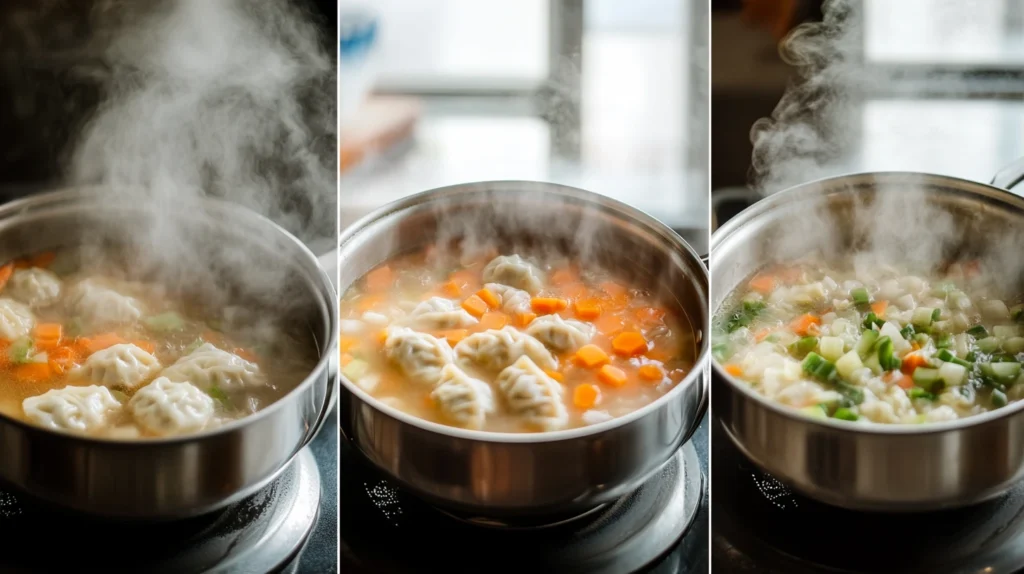
Step-by-Step Cooking Instructions
Here’s a simple and flexible recipe to create the perfect potsticker soup in under 30 minutes. This method works well with both frozen and homemade dumplings.
Ingredients:
- 8–10 frozen or homemade potstickers
- 6 cups chicken or vegetable broth
- 1 tablespoon sesame oil
- 3 garlic cloves, minced
- 1 tablespoon fresh ginger, grated
- 2 tablespoons soy sauce
- 1 teaspoon rice vinegar (optional)
- 1 cup thinly sliced carrots
- 1 cup napa cabbage or bok choy, chopped
- ½ cup sliced mushrooms (shiitake or cremini)
- 1 cup baby spinach (added at the end)
- 2 green onions, thinly sliced
- Chili oil, fresh lime, or sesame seeds (for garnish)
Instructions:
- Sauté aromatics
In a large pot, heat the sesame oil over medium heat. Add garlic and ginger and sauté for 1–2 minutes until fragrant. - Add broth and seasoning
Pour in the broth, soy sauce, and rice vinegar. Bring to a gentle boil. - Add vegetables
Toss in carrots, mushrooms, and cabbage. Simmer for 5–7 minutes until vegetables start to soften. - Cook the potstickers
Carefully place the potstickers into the broth. Let them simmer for 5–7 minutes if frozen (or about 4 minutes if fresh) until cooked through. - Final touches
Add spinach and half the green onions. Stir gently and cook for another minute. - Serve hot
Ladle soup into bowls and top with remaining green onions, sesame seeds, chili oil, or lime wedges.
Cooking Tips for Perfect Texture and Flavor
To ensure your potsticker soup is rich in flavor and texture, keep these expert tips in mind:
- Use low-sodium broth so you can better control the saltiness with soy sauce or miso.
- Sauté aromatics first to unlock deeper layers of flavor before adding liquid.
- Simmer, don’t boil—too much heat can cause potstickers to break apart or overcook.
- Layer vegetables by cook time: Start with firmer veggies like carrots, then finish with delicate greens.
- Balance your bowl: Use enough potstickers per person—generally 3 to 4 per serving is ideal.
🍲 Flavor booster tip: Add a few drops of toasted sesame oil or chili garlic sauce right before serving to wake up the broth.
Common Mistakes to Avoid
While potsticker soup is beginner-friendly, a few missteps can affect the outcome. Watch out for these common mistakes:
- Overcrowding the pot: Too many dumplings in the pot can make them stick or tear. Cook in batches if needed.
- Using cold potstickers in hot broth: This causes the broth temperature to drop quickly and may lead to uneven cooking. Allow frozen dumplings to sit at room temp for 2–3 minutes before adding.
- Overcooking vegetables: Veggies like spinach and bok choy only need a minute or two to wilt—don’t let them go mushy.
- Skipping the taste test: Always taste your broth before serving. A small splash of soy sauce, vinegar, or lemon juice can make a huge difference.
✅ Keep it simple, but don’t skimp on quality—fresh aromatics and quality broth turn a good soup into a fantastic one.
Variations of Potsticker Soup
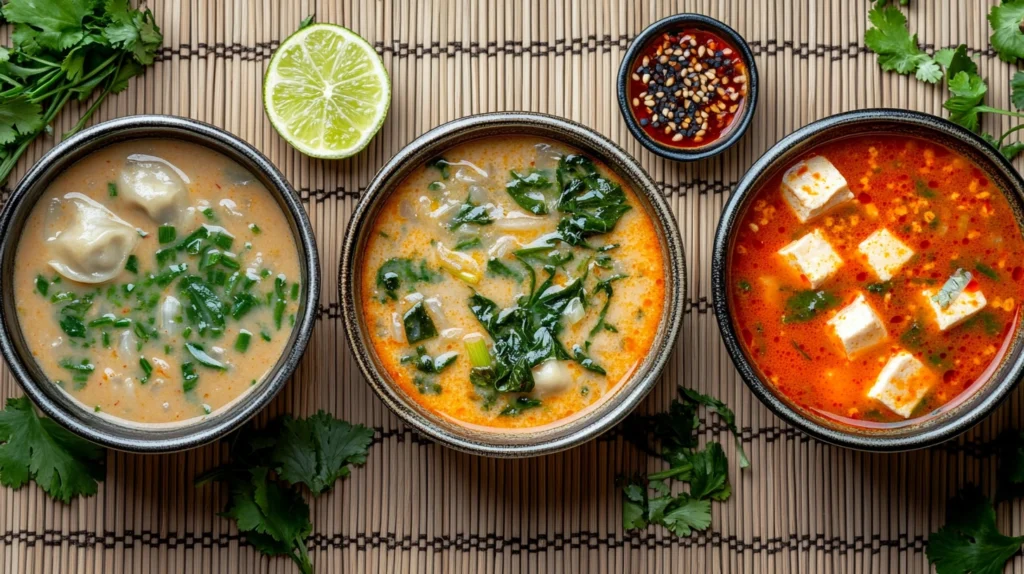
One of the most exciting aspects of Potsticker Soup is how easy it is to customize. Whether you follow a plant-based lifestyle, love bold spices, or want something rich and creamy, there’s a version for everyone. Below, you’ll find a few popular variations to inspire your next bowl.
Vegan and Vegetarian Versions
Plant-based Potsticker Soup is not only possible—it’s downright delicious. With the growing availability of vegan dumplings and flavorful broths, this variation has become a favorite for health-conscious eaters.
Here’s how to make it vegan:
- Use vegetable broth: Opt for low-sodium or homemade veggie stock as your base.
- Choose vegan potstickers: Look for dumplings filled with tofu, mushrooms, cabbage, or other plant-based ingredients. Popular vegan brands include Nasoya and Annie Chun’s.
- Add plant-based protein: Toss in cubes of tofu or edamame for a protein boost.
- Flavor enhancers: Use tamari instead of soy sauce (for gluten-free), and add nutritional yeast for extra umami.
💚 Pro Tip: A splash of coconut aminos can add a slightly sweet depth to your broth without overpowering it.
Spicy Korean-Inspired Potsticker Soup
For those who enjoy bold, fiery flavors, a Korean twist on Potsticker Soup adds just the right kick. This version draws inspiration from Korean soups like tteokguk and kimchi jjigae.
Key ingredients for this variation:
- Gochujang (Korean chili paste): Adds heat, umami, and a touch of sweetness.
- Kimchi: Fermented napa cabbage gives the soup a tangy, spicy base and tons of probiotics.
- Korean potstickers (mandu): Available in Asian grocery stores, often larger and heartier.
- Scallions and sesame oil: Classic Korean aromatics.
Cooking tip: Start by sautéing kimchi and gochujang in sesame oil before adding your broth. This unlocks intense flavor right from the beginning.
🔥 Want it spicier? Add thin slices of fresh chili peppers or a spoonful of chili crisp on top.
Creamy Potsticker Soup Twist
Want something warm and filling? Try creamy potsticker soup—it might become your new favorite. This tasty mix takes ideas from Thai coconut soup and smooth, creamy Western-style soups.
How to make it creamy:
- Add coconut milk: Stir in one can of full-fat coconut milk toward the end of cooking for a velvety texture.
- Lemongrass and lime: These brighten the richness and pair well with potstickers filled with shrimp or vegetables.
- Mushrooms and spinach: These work beautifully in creamy broths.
- Finish with herbs: Top with fresh cilantro, Thai basil, or mint for a fresh, vibrant contrast.
🥥 Optional: Add a spoonful of peanut butter and a dash of fish sauce for a Thai-inspired twist with a nutty finish.
Nutritional Information & Health Benefits
Calories, Protein, Carbs, and Fiber
Potsticker Soup is a healthy choice, especially when you add lots of vegetables and use a simple, clean broth. The number of calories in each bowl depends on the kind of potstickers and broth you use, but here’s a general idea for one average serving (1 bowl with 4 potstickers and some vegetables):
- Calories: 300–450 kcal
- Protein: 10–18 grams
- Carbohydrates: 30–45 grams
- Fat: 10–18 grams
- Fiber: 3–6 grams
Using lean meats, light broth, and low-salt soy sauce helps keep the meal healthy and easy on the heart. Adding fiber-rich vegetables like cabbage, spinach, or kale helps with digestion and keeps you feeling full.
For those on specific diets:
- Low-carb: Skip the starchier dumplings and opt for low-carb versions.
- High-protein: Add tofu or shredded chicken to increase protein.
- Gluten-free: Use gluten-free soy sauce (tamari) and GF-labeled dumplings.
🥬 Tip: A handful of microgreens or a boiled egg can boost nutrition and add visual appeal.
Nutrient Boosting Ingredients to Add
Want to supercharge your potsticker soup? Consider adding these nutrient-packed ingredients:
- Seaweed (wakame or nori) – Rich in iodine, minerals, and antioxidants.
- Turmeric – Anti-inflammatory and adds a golden hue to the broth.
- Miso paste – Adds probiotics and umami; best stirred in at the end.
- Tofu or tempeh – Great vegetarian protein sources.
- Quinoa or soba noodles – For a more filling twist with added fiber and B vitamins.
Potsticker Soup vs. Other Dumpling Soups
Wonton Soup vs. Potsticker Soup
Both Wonton Soup and Potsticker Soup feature dumplings in broth, but there are key differences:
- Dumpling Type: Wontons are smaller, more delicate, and usually boiled. Potstickers are heartier, often pan-fried before being added to soup.
- Texture: Potstickers have a firmer, sometimes crispy edge. Wontons melt in your mouth.
- Broth: Wonton soup typically uses a lighter, clear broth. Potsticker soup leans toward a more robust and customizable base.
- Prep Time: Potsticker soup (especially with frozen dumplings) is quicker and easier for weeknight meals.
Miso Dumpling Soup vs. Potsticker Soup
Key differences:
- Base Flavor: Miso soup has a deep fermented flavor, while potsticker soup varies from savory to spicy or creamy.
- Protein: Potstickers often include meat or seafood; miso soups are more tofu-based.
- Cultural Background: Miso soup is deeply rooted in Japanese tradition, while potsticker soup is a newer fusion of Chinese dumplings with global soup styles.
Serving Suggestions and Pairings
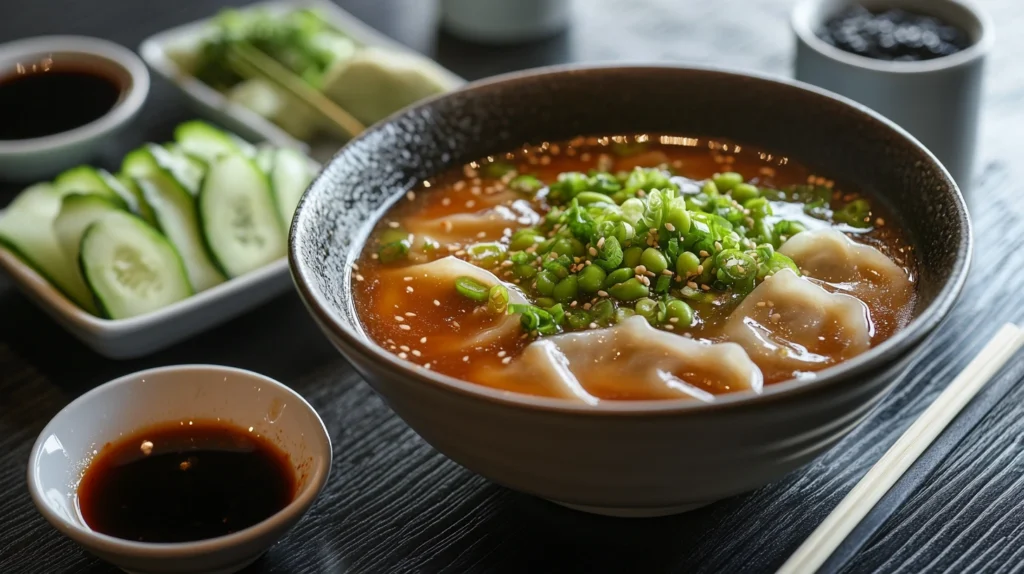
What to Serve with Potsticker Soup
While Potsticker Soup can certainly stand alone, it pairs wonderfully with a variety of side dishes:
- Asian slaw with sesame vinaigrette
- Steamed edamame with sea salt
- Pickled vegetables like kimchi or radish
- Sticky rice or jasmine rice as a hearty side
- Cucumber salad with soy-lime dressing for a refreshing contrast
If you’re hosting a dinner, start with miso soup shooters or seaweed salad, and follow up with the soup as a main course.
Presentation Tips and Bowl Ideas
Presentation elevates the experience of any dish. Here are some ways to make your soup visually stunning:
- Use deep ramen or pho bowls to showcase the broth and dumplings.
- Top with a swirl of chili oil and finely chopped scallions for color.
- Garnish with toasted sesame seeds or a lime wedge on the side.
- Use contrasting colored veggies like red bell peppers or purple cabbage.
🍜 Serving Tip: Serve with a soup spoon and chopsticks—this encourages slower eating and enjoyment of each bite.
Storage and Reheating Tips
How to Store Leftover Potsticker Soup Properly
To keep leftovers tasting fresh:
- Separate the potstickers from the broth if storing for more than one day. This prevents them from getting soggy.
- Store in airtight containers and refrigerate for up to 3 days.
- Freeze broth separately in freezer-safe containers for up to 2 months.
📦 Label the containers with the date and ingredients if you’re making multiple batches or variations.
Best Practices for Reheating Without Overcooking
Potstickers are delicate after cooking, so reheating properly is key:
- Stovetop method: Reheat the broth over medium heat. Add potstickers for the last 2–3 minutes until warmed through.
- Microwave method: Use a microwave-safe bowl. Add broth and dumplings, cover loosely, and heat in 30-second intervals to avoid overheating.
- Avoid boiling: High heat can cause potstickers to split or fall apart.
🧊 If frozen, thaw the soup overnight in the fridge before reheating for the best texture.
Frequently Asked Questions
Can you use potstickers in soup?
Yes, you can definitely use potstickers in soup—and that’s what makes Potsticker Soup so great! Whether you make them at home or buy them frozen, potstickers work well in hot broth if cooked the right way. Just let them gently simmer in the soup until they’re warm all the way through. If they’re frozen, you don’t need to thaw them—just cook them a few minutes longer.
Using potstickers in soup transforms a classic appetizer into a filling, comforting meal. Their hearty fillings and chewy texture make them ideal for soaking up rich, aromatic broths without falling apart.
📝 Tip: Avoid rapid boiling, as it may cause the wrappers to break open and lose the filling into the soup.
What is the difference between soup dumplings and potstickers?
The main difference lies in the preparation, texture, and purpose:
- Soup dumplings (like xiao long bao) are typically steamed and filled with meat and gelatinous broth, which melts into soup when heated—creating a dumpling that contains soup inside.
- Potstickers, on the other hand, are usually pan-fried before being boiled or steamed. They’re not filled with soup but are added to soup for texture and flavor.
Soup dumplings are delicate and meant to be eaten with care, often with a spoon to catch the liquid inside. Potstickers are heartier, more versatile, and stand up well in brothy soups or as standalone appetizers.
What can you do with potstickers?
Potstickers are incredibly versatile, and there’s so much more you can do with them beyond dipping sauces. Here are a few creative ways to use potstickers:
- In soup: Like Potsticker Soup, of course!
- Pan-fried appetizers: Serve golden and crispy with dipping sauces like soy-ginger, chili oil, or ponzu.
- Dumpling salad: Add chopped potstickers to a bed of greens and Asian slaw for a dumpling salad bowl.
- Stir-fry: Slice and sauté with vegetables, rice, and sauce for a quick potsticker stir-fry.
- Dumpling tacos: Wrap fried potstickers in lettuce or tortillas with spicy mayo and pickled veggies.
🥟 They’re a freezer staple for a reason—quick, filling, and endlessly adaptable!
What is a good side dish for Potsticker Soup?
Potsticker Soup is a meal on its own, but pairing it with the right sides can elevate your dining experience. Great side dishes include:
- Asian cucumber salad – Crisp and tangy, balances the warm broth.
- Steamed edamame – Light, protein-rich, and fun to eat.
- Sticky rice or jasmine rice – For a heartier meal.
- Kimchi or pickled veggies – Add spice and crunch.
- Spring rolls or egg rolls – For a textural contrast and extra indulgence.
🥢 For a lighter option, serve with green tea or miso soup as a warm-up course.
Conclusion
Potsticker Soup is more than just a quick meal—it’s a flavorful fusion of comfort and convenience. With just a few simple ingredients and minimal prep time, you can transform everyday potstickers into a rich, aromatic soup that satisfies every craving. The blend of umami broth, tender vegetables, and soft-yet-slightly-crispy dumplings creates a balanced dish that feels both nourishing and indulgent.
Perfect for busy weeknights, cozy weekends, or impressing guests with minimal effort, this soup proves that great flavor doesn’t have to take hours to achieve. Plus, with endless customization options—like swapping in veggie dumplings, adding chili oil, or tossing in noodles—you’ll never get bored.
So the next time you’re craving a warm, hearty meal that comes together fast, reach for your potstickers and make this soup your new go-to favorite.
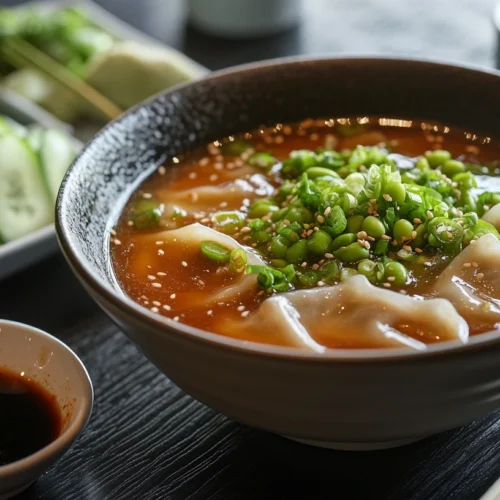
Easy Homemade Potsticker Soup
Equipment
- Large soup pot or Dutch oven
- Wooden spoon or spatula
- Chef’s knife
- Cutting board
- Ladle
- Measuring spoons and cups
Ingredients
- 8 –10 frozen or homemade potstickers pork, chicken, or vegetarian
- 1 tablespoon sesame oil
- 3 garlic cloves minced
- 1 tablespoon fresh ginger grated
- 6 cups low-sodium chicken or vegetable broth
- 2 tablespoons soy sauce
- 1 teaspoon rice vinegar optional
- 1 cup napa cabbage or bok choy chopped
- 1 cup carrots thinly sliced
- ½ cup mushrooms shiitake or cremini, sliced
- 1 cup baby spinach
- 2 green onions sliced (divided)
- Optional toppings: chili oil sesame seeds, lime wedges, fresh herbs
Instructions
- Sauté aromatics: In a large soup pot, heat sesame oil over medium heat. Add garlic and ginger, and cook for 1–2 minutes until fragrant.
- Add broth and seasoning: Pour in broth, soy sauce, and rice vinegar. Bring to a gentle boil.
- Add vegetables: Stir in carrots, mushrooms, and cabbage. Simmer for 5–7 minutes until just tender.
- Cook potstickers: Carefully add frozen (or fresh) potstickers to the soup. Simmer for 5–7 minutes (or 4–5 minutes if fresh) until cooked through.
- Finish with greens: Add spinach and half of the green onions. Simmer 1–2 minutes until wilted.
- Serve: Ladle into bowls and top with remaining green onions, chili oil, sesame seeds, or herbs. Serve hot.

